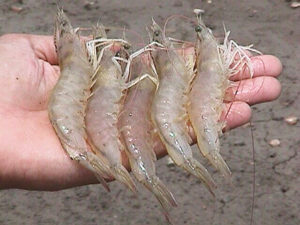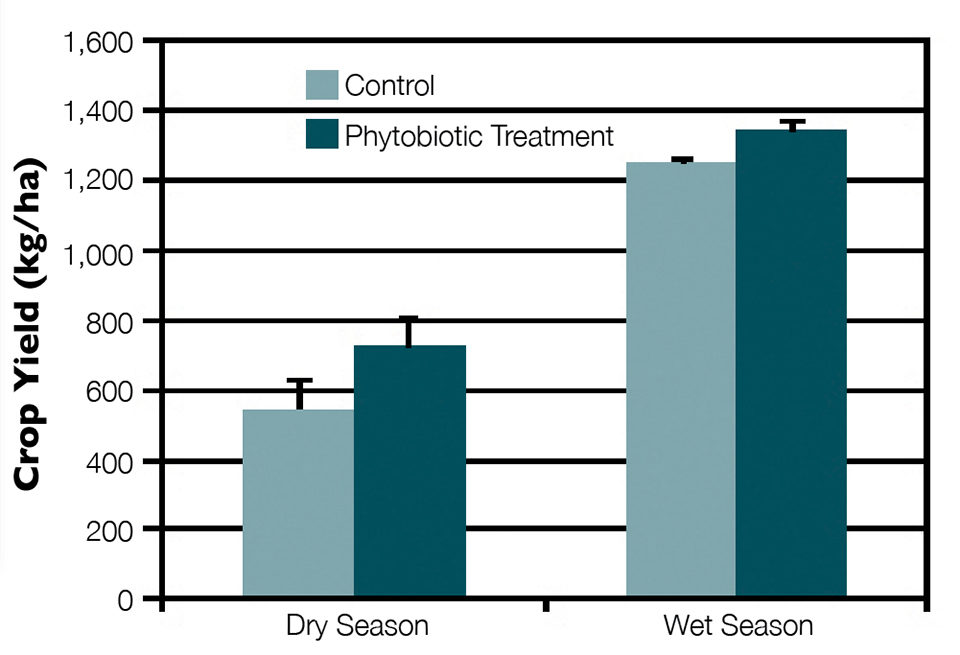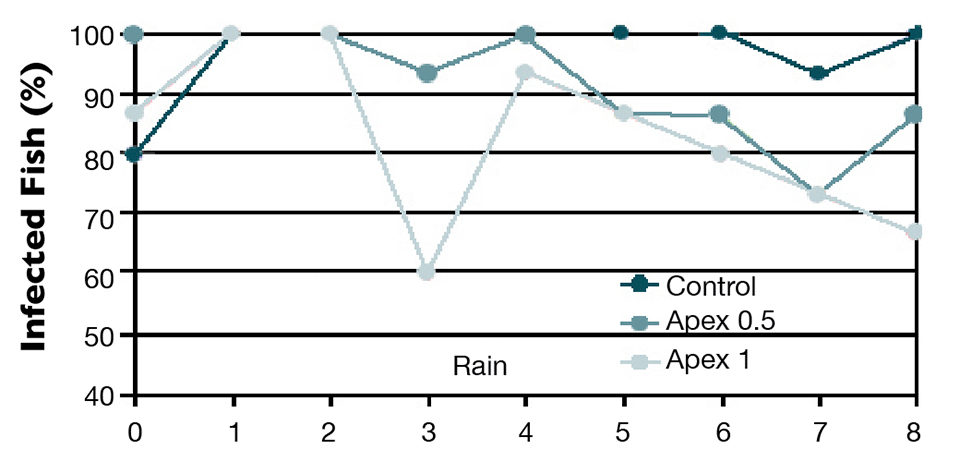Significant effects obtained only for the highest dosages

The strong fluctuations of feed ingredient prices in combination with low market prices for fish and shrimp are challenging the profitability of aquaculture operations. This has accelerated a search for alternative formulations and feed additives to improve the cost efficiency of feeding under various scenarios of ingredient cost and availability.
As demonstrated in trials, phytobiotic feed additives have the potential to enhance aquaculture productivity and reduce the impacts of diseases and parasites on farm economics.
Optimized gut health
The ban on the use of antibiotic growth promoters in poultry and pigs, and the subsequent search for alternatives, has reinforced the importance of gut health and the development of a stable, favorable gut microflora for feed efficiency, overall performance and productivity.
Fish and shrimp are highly exposed to exchanges of micro-flora between the environment and their digestive systems. This increases the risk for the proliferation of unfavorable gut microflora or frequent destabilization of the microflora, which can affect the optimal functioning of the digestive systems. Furthermore, the digestive systems of fish and shrimp are the main entry ports for bacterial and viral infections, which remain a major risk for the profitability of aquaculture production.
Sustainable approaches to modulate the gut microflora in farmed animals include the use of selected bacteria to inoculate the gut (probiotics), specific nutrients that promote the development of selected bacterial strains (prebiotics) and natural compounds mostly derived from yeast and herbal extracts (phytobiotics).
These approaches are capable of adjusting the microflora toward a composition that favors the development of beneficial bacteria and inhibits potentially pathogenic microorganisms. The latter strategies have the advantage of being easily applicable at the feed mill on large volumes of feed, which avoids major adaptations of the production protocols at the farm.
Semi-intensive shrimp trial
The authors developed a synergistic blend of phytobiotics selected for their bacteriostatic and bactericidal properties against pathogenic and potentially pathogenic bacteria in vitro. This blend was capable of promoting growth in feeding trials with healthy specimens of seabream, tilapia and white shrimp. For example, under controlled lab conditions, shrimp that received feed supplemented with Sanacore GM, a commercial phytobiotic growth promoter, had 20 percent greater growth and 4 percent lower feed conversion than shrimp fed a control without phytobiotics.
The efficacy of phytobiotics was tested for white shrimp at the Camaco farm (Grupo Calesa) in Panama during two production cycles: the September 2009 to February 2010 dry season and March to November 2010 wet season. The dry season in Panama is characterized by unstable climatological conditions and strong temperature fluctuations which, in turn, affect shrimp growth and increase the impacts of white spot syndrome virus (WSSV). The wet season provides more suitable growth conditions and generally results in better survival and productivity.
The two treatments compared differed only with regard to the supplementation of the standard feed with the phytobiotic growth promoter.
Results
The phytobiotic additive drastically improved survival, raising it 24 percent during the dry cycle and 18 percent during the wet cycle over survival rates for the control groups (Fig. 1). Harvested crop yields improved 35 and 7 percent, respectively, over yields for the controls during the dry and wet cycles (Fig. 2).


The more significant effects of the phytobiotic product on survival and harvests during the dry cycle may be related to the fact that white spot syndrome outbreaks with similar frequency and severity were observed in both treatments. The synergistic blend of phytobiotics with antimicrobial activity may have protected the shrimp from coinfections with opportunistic bacteria, often the major cause of mortality in WSSV-infected shrimp.
Pangasius study
The rapid development of Pangasius hypophthalmus culture in Vietnam has led to intensive culture practices where stressors such as crowding and poor water quality are common. As a result, farmed catfish become susceptible to diseases and parasitic infestations such as monogenean ectoparasites on the gills.
A study by the Department of Fish Pathology at Nong Lam University in Ho Chi Minh City, Vietnam, is evaluating the effects of dietary administration of Apex Aqua, a commercial blend of botanical extracts with anti-bacterial and anti-parasitic activities, on the performance and resistance of tra catfish against monogenean gill parasites.
A non-supplemented control feed and two feeds with different dosage levels of the blend of botanical extracts – Apex 0.5 and Apex 1, supplemented with 0.5 and 1 kg additive/mt feed – were evaluated. The eight-week trial was conducted in nine 2- x 4- x 1.5-m hapas with fingerlings of 9- to 11 g in a nursery pond located in Thotnot District, Cantho Province. Each hapa contained 640 fish at a density of 80 fish/m2. The fish were fed the commercial diet twice daily to apparent satiation.
The physicochemical parameters, temperature, dissolved oxygen, ammonia and pH values of water in the pond were checked weekly and remained within acceptable ranges. Five fish from each hapa were examined weekly for monogenean infection in the gills.
Results
The supplementation of the botanical complex improved the fish performance in terms of growth and feed conversion with significant effects obtained only for the highest dosage (Table 1). Although not significant, there was a trend for improved survival with increasing dosage of the botanical extracts. Feed intake was not affected by the supplementation of the feed additive in this trial.
Coutteau, Performance of Pangasius fed different levels of botanical extracts, Table 1
| Parameter | Treatment Control | Treatment Botanicals 0.5 kg/mt | Treatment Botanicals 1.0 kg/mt |
|---|
Parameter | Treatment Control | Treatment Botanicals 0.5 kg/mt | Treatment Botanicals 1.0 kg/mt |
|---|---|---|---|
| Initial weight (g) | 10.0a | 9.9a | 10.3a |
| Final weight (g) | 67.6a | 69.9ab | 71.4b |
| Specific growth rate (%/day) | 3.01a | 3.05a | 3.13b |
| Feed intake (g/fish/day) | 1.46a | 1.49a | 1.44a |
| Feed-conversion ratio | 1.42a | 1.41a | 1.34b |
| Survival (%) | 83a | 85a | 90a |
The intensity of monogenean infestation was significantly reduced from week two onwards for treatment Apex 1 and from week three for treatment Apex 0.5 (Fig. 3). At the end of the trial, about 67 percent of the fish in the group supplemented with the higher dosage of the phytobiotic were infected with monogenean, while nearly all the fish in the other treatments were infected.

(Editor’s Note: This article was originally published in the May/June 2011 print edition of the Global Aquaculture Advocate.)
Authors
-
Peter Coutteau, Ph.D.
Nutriad International N.V.
Schietstandlaan 2
2300 Turnhout, Belgium -
Alexander van Halteren
Nutriad International N.V.
Schietstandlaan 2
2300 Turnhout, Belgium -
Sam Ceulemans
Nutriad International N.V.
Schietstandlaan 2
2300 Turnhout, Belgium
Related Posts

Health & Welfare
Feed additives based on quorum sensing disruption could aid fight against EMS
The pathogenicity of early mortality syndrome in shrimp is likely regulated by quorum sensing, which allows the Vibrio bacteria that colonize shrimp guts to coordinate the release of the toxin that damages shrimp digestive systems.

Health & Welfare
Focus on gut health increases aquaculture productivity
Increased attention to nutrient digestibility and gut health are two important focus areas for technological development of manufactured feeds in the aquaculture industry. Both laboratory and field studies have demonstrated the potential benefits for aquaculture productivity and the economics of specific feed additives developed to stimulate the establishment of a healthy gut microflora.

Aquafeeds
Natural feed additive improves shrimp productivity
The digestive systems of shrimp are main entry points for bacterial and viral pathogens, and unfavorable microflora. Natural feed additives that combine different actions have proven effective in improving survival where shrimp are exposed to bacterial pathogens.

Health & Welfare
A case for better shrimp nutrition
Shrimp farm performance can often be below realistic production standards. Use proven nutrition, feeds and feeding techniques to improve profitability.


